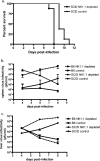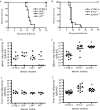Induction of natural killer cell responses by ectromelia virus controls infection
- PMID: 17287257
- PMCID: PMC1866162
- DOI: 10.1128/JVI.02061-06
Induction of natural killer cell responses by ectromelia virus controls infection
Abstract
Natural killer (NK) cells play a pivotal role in the innate immune response to viral infections, particularly murine cytomegalovirus (MCMV) and human herpesviruses. In poxvirus infections, the role of NK cells is less clear. We examined disease progression in C57BL/6 mice after the removal of NK cells by both antibody depletion and genetic means. We found that NK cells were crucial for survival and the early control of virus replication in spleen and to a lesser extent in liver in C57BL/6 mice. Studies of various knockout mice suggested that gammadelta T cells and NKT cells are not important in the C57BL/6 mousepox model and CD4+ and CD8+ T cells do not exhibit antiviral activity at 6 days postinfection, when the absence of NK cells has a profound effect on virus titers in spleen and liver. NK cell cytotoxicity and/or gamma interferon (IFN-gamma) secretion likely mediated the antiviral effect needed to control virus infectivity in target organs. Studies of the effects of ectromelia virus (ECTV) infection on NK cells demonstrated that NK cells proliferate within target tissues (spleen and liver) and become activated following a low-dose footpad infection, although the mechanism of activation appears distinct from the ligand-dependent activation observed with MCMV. NK cell IFN-gamma secretion was detected by intracellular cytokine staining transiently at 32 to 72 h postinfection in the lymph node, suggesting a role in establishing a Th1 response. These results confirm a crucial role for NK cells in controlling an ECTV infection.
Figures








Similar articles
-
Chronic Lymphocytic Choriomeningitis Infection Causes Susceptibility to Mousepox and Impairs Natural Killer Cell Maturation and Function.J Virol. 2020 Feb 14;94(5):e01831-19. doi: 10.1128/JVI.01831-19. Print 2020 Feb 14. J Virol. 2020. PMID: 31776282 Free PMC article.
-
Polarized type 1 cytokine response and cell-mediated immunity determine genetic resistance to mousepox.Proc Natl Acad Sci U S A. 2004 Jun 15;101(24):9057-62. doi: 10.1073/pnas.0402949101. Epub 2004 Jun 7. Proc Natl Acad Sci U S A. 2004. PMID: 15184649 Free PMC article.
-
T cell cytokine synthesis at the single-cell level in BALB/c and C57BL/6 mice infected with ectromelia virus.Postepy Hig Med Dosw (Online). 2012 Apr 20;66:222-30. doi: 10.5604/17322693.991606. Postepy Hig Med Dosw (Online). 2012. PMID: 22706108
-
The Pathogenesis and Immunobiology of Mousepox.Adv Immunol. 2016;129:251-76. doi: 10.1016/bs.ai.2015.10.001. Epub 2015 Nov 21. Adv Immunol. 2016. PMID: 26791861 Review.
-
The inflammatory and immune response to mousepox (infectious ectromelia) virus.Acta Virol. 1994 Oct;38(5):299-307. Acta Virol. 1994. PMID: 7726007 Review.
Cited by
-
Chronic Lymphocytic Choriomeningitis Infection Causes Susceptibility to Mousepox and Impairs Natural Killer Cell Maturation and Function.J Virol. 2020 Feb 14;94(5):e01831-19. doi: 10.1128/JVI.01831-19. Print 2020 Feb 14. J Virol. 2020. PMID: 31776282 Free PMC article.
-
Smallpox vaccines: targets of protective immunity.Immunol Rev. 2011 Jan;239(1):8-26. doi: 10.1111/j.1600-065X.2010.00975.x. Immunol Rev. 2011. PMID: 21198662 Free PMC article. Review.
-
Vaccinia virus protein K7 is a virulence factor that alters the acute immune response to infection.J Gen Virol. 2013 Jul;94(Pt 7):1647-1657. doi: 10.1099/vir.0.052670-0. Epub 2013 Apr 11. J Gen Virol. 2013. PMID: 23580427 Free PMC article.
-
α2β1 Integrin Is Required for Optimal NK Cell Proliferation during Viral Infection but Not for Acquisition of Effector Functions or NK Cell-Mediated Virus Control.J Immunol. 2020 Mar 15;204(6):1582-1591. doi: 10.4049/jimmunol.1900927. Epub 2020 Feb 3. J Immunol. 2020. PMID: 32015010 Free PMC article.
-
Modulation of NKp30- and NKp46-mediated natural killer cell responses by poxviral hemagglutinin.PLoS Pathog. 2011 Aug;7(8):e1002195. doi: 10.1371/journal.ppat.1002195. Epub 2011 Aug 25. PLoS Pathog. 2011. PMID: 21901096 Free PMC article.
References
-
- Afkarian, M., J. R. Sedy, J. Yang, N. G. Jacobson, N. Cereb, S. Y. Yang, T. L. Murphy, and K. M. Murphy. 2002. T-bet is a STAT1-induced regulator of IL-12R expression in naive CD4+ T cells. Nat. Immunol. 3:549-557. - PubMed
-
- Bendelac, A., M. N. Rivera, S. H. Park, and J. H. Roark. 1997. Mouse CD1-specific NK1 T cells: development, specificity, and function. Annu. Rev. Immunol. 15:535-562. - PubMed
-
- Biron, C. A., K. S. Byron, and J. L. Sullivan. 1989. Severe herepesvirus infections in an adolescent without natural killer cells. N. Engl. J. Med. 320:1731-1735. - PubMed
-
- Brooks, C. R., T. Elliott, P. Parham, and S. I. Khakoo. 2006. The inhibitory receptor NKG2A determines lysis of vaccinia virus-infected autologous targets by NK cells. J. Immunol. 176:1141-1147. - PubMed
Publication types
MeSH terms
Substances
Grants and funding
LinkOut - more resources
Full Text Sources
Other Literature Sources
Research Materials

